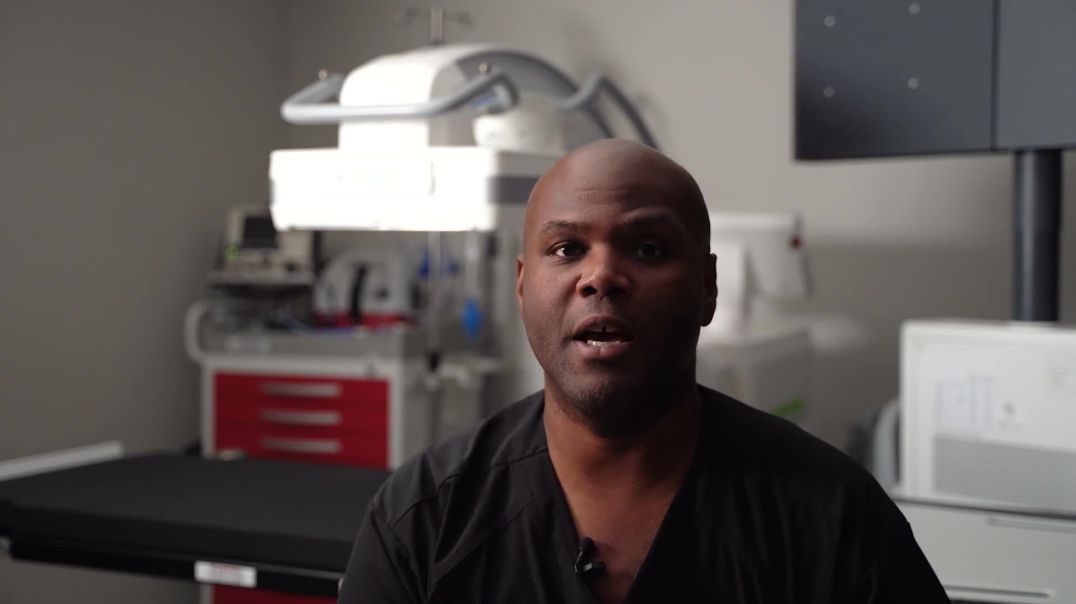Top videos
What Is It? Your wisdom teeth (third molars) usually start to erupt (enter your mouth) during the late teen years. Sometimes, there's not enough room for them. They may come into your mouth partially or not at all. Partial eruption of a wisdom tooth can create a flap of gum tissue next to the tooth. The flap can trap bits of food and debris. It can turn into a hotbed for bacteria. It's called pericoronitis if the tissue around the tooth becomes inflamed. Pericoronitis also can occur around a wisdom tooth that is still completely under the gums. Symptoms Symptoms include: Painful, swollen gum tissue in the area of the affected tooth. It can be difficult to bite down comfortably without catching the swollen tissue between your teeth. A bad smell or taste in the mouth Discharge of pus from the gum near the tooth More serious symptoms include: Swollen lymph nodes under your chin (the submandibular nodes) Muscle spasms in the jaw Swelling on the affected side of the face Diagnosis Usually, someone with pericoronitis goes to the dentist, complaining of pain in the area of the back tooth. Pericoronitis is diagnosed during the clinical exam. Your dentist will see inflamed gum tissue in the area of the unerupted or partly erupted wisdom tooth. The gums may be red, swollen or draining fluid or pus. Expected Duration Pericoronitis can be managed with antibiotics and warm salt water rinses. It goes away in about one week. However, it can return. This is likely to happen if the tooth does not completely enter the mouth and food and bacteria keep building up under the gum. Prevention You can help to prevent pericoronitis by brushing any erupting wisdom tooth and flossing around it. This will help make sure that food and bacteria do not build up under the gums. However, sometimes these steps do not work. If pericoronitis returns, you may need to have the flap of gum tissue removed. In some cases, the flap of tissue grows back and the wisdom tooth will need to be extracted. Treatment Pericoronitis can be tricky to treat. That's because the flap of gum tissue won't go away until the wisdom tooth emerges naturally, the tissue is removed or the tooth is removed. Your dentist will clean the area thoroughly by rinsing under the flap with water to remove bits of food and pus. Your dentist also may need to remove damaged tissue. If the area is infected, you'll most likely be given antibiotics. Your dentist will explain how to keep the area clean, which is the best way to prevent the problem from returning. This usually involves brushing and flossing daily and rinsing your mouth with water several times a day. These steps will help to prevent food from getting stuck under the gum flap. In some cases, your dentist may suggest removing the erupting tooth. Or the dentist may want to remove the tooth above it, which bites down on the gum below. If your dentist thinks the tooth may erupt fully into the mouth without problems, he or she may leave it alone. However, if pericoronitis comes back, the tooth may be extracted. Pericoronitis that causes symptoms should be treated as soon as possible. If it is not, the infection can spread to other areas of your mouth. The most severe cases are treated in a hospital. They sometimes require intravenous antibiotics and surgery. When To Call a Professional If you have symptoms of pericoronitis, make an appointment to see your dentist. If your wisdom teeth are coming in, visit your dentist at least twice a year for regular checkups. During those visits, the dentist can check on the progress of your wisdom teeth. Prognosis Pericoronitis does not cause any long-term effects. If the affected tooth is removed or erupts fully into the mouth, the condition cannot return.
Pathology: Previous spinal cord injury, diabetes, renal failure, dynamic knee contracture, open left ankle disarticulation for sepsis and severe foot infection
As a pediatric surgeon at NewYork-Presbyterian/Weill Cornell Medical Center, Dr. Nitsana Spigland treats newborns, children, teens, and young adults requiring surgical interventions. She specializes in antenatal counseling and newborn congenital malformations.
Learn more about Dr. Spigland at: https://www.nyp.org/physician/nspigland.
Vilitra 20mg is based tablet that contains the ingredient known as vardenafil (20 mg) which is utilized for the treatment of Ed or impotence in men.Ed is known as Erectile dysfunction where a man cannot achieve a firm erection sufficient for the intercourse.Vilitra 20mg performs this task and assists you in achieving that firm erection.This medicine has a very light dosage so as a newcomer there is no issue in that but especially doctor prescribes your dosage that how much you can consume it like how much you can ingest in and your body tolerance and even based on the severity of your condition.The ingredient which is applied in this product which is vardenafil that belongs to class of PDE5 inhibitors similar to tadalafil and sildenafil citrate.Avoid fatty foods before taking this product because it decreases the efficacy.Alcohol intake is not recommended as the combination will cause decrease in efficacy and even can lower the blood pressure level combinely in a lethal manner so you shouldn't consume it before taking this product. store it in a cool and a dry place away from moisture.Buy Vilitra 20mg online at our web store https://www.firstchoicemedss.com/vilitra-20mg.html
A medicine named Super P Force 160mg was developed to support men with erectile dysfunction and premature ejaculation, two common sensual problems. Together, the two active products—sildenafil citrate and dapoxetine—support men to achieve and maintain a stronger erection while delaying ejaculation and extending sensual pleasure. Rebuilding confidence in one's sensual abilities is one of Super P Force 160 mg's largest benefits for men. This can enhance relationships and overall well-being. Men are able to experience a more rewarding and pleasurable sensual experience, enhancing intimacy and connection with their lover, by treating both premature ejaculation and erectile dysfunction. Moreover, Super P Force 160 mg is a drug that has professionally been demonstrated to support men who have a problem with sensuality. It is safe and efficient. Men have ample time to indulge in sensual activity without fear of losing erection or premature ejaculation due to its simple to apply and up to 4-hour duration. In conclusion, Super P Force 160 mg is an excellent medication for men who would like to enjoy a more fulfilling sensual existence and improve their sensual performance.Buy Super P Force 160mg online at our web store https://www.firstchoicemedss.c....om/super-p-force-160
There is a product available on the market, Zyhcg 10000, which can be used to treat infertility in men and women and issues associated with children's puberty.The key active ingredient used in the formulation of this product is human chorionic gonadotrophin. You can buy Zyhcg 10000 injection online. This hormone, also referred to as HCG, is extracted from pregnant women's placental cells to assist in treating infertility in both men and women. It brings back a woman's ovary's function of laying eggs, which was lost due to infertility-related complications earlier. It increases the sperm count of males.This product cures many childhood diseases, such as delayed puberty, but has to be used with a prescription; otherwise, it cannot be used. The doctor's prescription, that is the way it is advised to you, decides the dose and treatment duration.Women who are not able to conceive sometimes suffer from psychological issues along with physical issues, because some infertilities are only physical in nature and others are caused due to excessive tension or stress.Buy Zyhcg 10000 injection online at our web store https://www.firstchoicemedss.c....om/zyhcg-10000-iu-in
Precision Vascular Kentucky specializes in innovative treatments for peripheral arterial disease (PAD), uterine fibroids, and debilitating joint pain affecting hips, knees, and shoulders. Led by Dr. Jean-Baptiste in Louisville, we are dedicated to "Restoring Flow! Saving Limbs! Changing Lives!" through advanced interventional procedures. We excel in treating PAD-related leg and foot pain, particularly for diabetic patients over 50 with non-healing wounds who may face amputation recommendations. Our expertise includes limb salvage through procedures like angioplasty and angiograms. For women suffering from uterine fibroids causing heavy bleeding and pelvic pressure, we offer uterine fibroid embolization (UFE) as an alternative to hysterectomy. Our joint pain treatments, including genicular artery embolization (GAE), provide hope for patients told they're too young for knee or hip replacement. We treat pain and stiffness through minimally invasive procedures that can eliminate what patients describe as "suicide pain." Precision Vascular Kentucky serves Louisville, Kentucky and Southern Indiana, working with multiple insurance providers. Our patient-centered approach combines cutting-edge endovascular treatments with compassionate care, helping patients achieve pain-free movement and improved quality of life when traditional alternatives may not be effective. For more info, visit us at https://precisionvascularkentucky.com/blog/ and https://precisionvascularkentu....cky.com/peripheral-a
Phone: (502) 365-4151
Address: 512 Executive Park, Louisville, KY, 40207, USA
Bimat 0.03% is a revolutionary eye drop that successfully controls glaucoma and ocular hypertension and stimulates eyelash growth. Designed to lower intraocular pressure, Bimat lowers intraocular pressure by enhancing the drainage of fluid out of the eye to help save your vision and maintain eye health. Used regularly, you can experience significant improvements and live free of concern about high eye pressure.You can buy BIMAT 0.03% bottle online cheap on trusted sources. But wait, there's more! Bimat 0.03% is also famous for causing fuller, darker, and longer eyelashes. The active ingredient excites the hair follicles, thus promoting the growth of new lashes and totally transforming your looks without any trouble. Most of the customers have noticed significant improvements, and Bimat is therefore a must-have in everyone's beauty arsenal. With its ease of use and twofold benefit, Bimat 0.03% is the best choice for therapeutic as well as cosmetic effects. Consult your eye care professional how Bimat can provide you with healthier eyes and beautiful lashes.Buy bimat 0.03% online at our web store https://www.firstchoicemedss.c....om/bimat-0-03-bimato
In this video, we discuss the common concerns and misunderstandings about insurance coverage for gynecomastia surgery. Many patients wish for their insurance to cover this procedure, but it's important to understand that this decision is not influenced by the doctor or hospital but solely depends on your insurance policy.
Most insurance companies in India do not cover gynecomastia surgery as it is considered a cosmetic procedure. However, you can communicate with your insurance provider and what documentation we can provide to assist your claim if your insurance policy covers it.
In the video, we also discuss the ethical considerations and why it's important to be honest in your documentation.
Thank you for watching!
Be a part of our Gynecomastia community.
✅ Get insights from our patient community
✅ Ask our board-certified plastic surgeons anything
✅ View the before-and-after patients' results
✅ Connect with other patients & ask them about their experience
✅ First of its a kind initiative in INDIA for patient education and interaction
Join our community: https://drrajatgupta.com/community/
Gynecomastia Helpline: +91 95689 99333
Related Video:
1. Can Gynecomastia be cured non surgically?: https://www.youtube.com/watch?v=kXy5ZyrU-Sk
2. 8 Gynecomastia Surgery Myths: https://www.youtube.com/watch?v=2vzJUdfphc8&t=5s
3. The Ultimate Guide to Gynecomastia Surgery: https://www.youtube.com/watch?v=zFFHjO_uIDw&t=25s
4. Risk involved in Gynecomastia Surgery: https://www.youtube.com/watch?v=vw2diQ-T8K8
------------------------------------------------------------------------------------------------------------------------
About Dr. Rajat Gupta and RG Aesthetics
At RG Aesthetics, India’s best plastic surgeon, Dr. Rajat Gupta is at your service! With 13 years of experience, brand certification, and international recognition, Dr. Gupta is the solution to all your contouring needs.
His expertise in liposuction techniques combined with the state-of-the-art technology available at RG Aesthetics ensures we continue providing the most reliable services with incredible, instantaneous results!
Our equipment allows for every kind of liposuction there is – especially the minimally invasive kinds. Dr. Gupta reflects RG Aesthetics’ belief of the patient’s comfort always being paramount. Procedures at RG Aesthetics, under Dr. Rajat Gupta, minimize trauma and speed up recovery time for the best results!
Schedule a Consultation:
✅ Call: +91 - 9251-711-711
✅ contact@drrajatgupta.com
✅ Visit: https://www.drrajatgupta.com
✅https://www.instagram.com/rajatguptadr
✅https://www.facebook.com/drrajatgupta/
✅https://www.linkedin.com/in/rajat-gupta-9a6b23119/
#gynecomastia #plasticsurgery #insurancecoverage #cosmeticsurgery #healthinsurance #gynecomastiasurgery #medicaladvice #drrajatgupta #delhisurgeon #ckbirlahospital #patienteducation #medicalethics #healthcareindia #rgaesthetics #boardcertifiedplasticsurgeon
Buy Femalefil 10mg Tablet is a powerful medicine intended only for women's use. The medicine has an active component of Female Tadalafil 10mg. Today Call Now!!!
Buy Now : https://www.rsmenterprises.in/....product/viewdetail/t
#rsmenterprises #health #healthcare #femaletadalafil10mg #femalefil10mg #femalegenericcialis #femalesensualpills
One of the most common fears patients have before plastic surgery is, “Will my results look fake?” Whether it’s rhinoplasty, a facelift, breast augmentation, or a tummy tuck, this concern is completely natural.
In this video we explain how skilled techniques and careful planning ensure that your results look natural and enhance your own features.
Plastic surgery is both a science and an art. It’s not just about medical knowledge but also about artistic shaping, precise technique, and understanding what not to overcorrect.
Breast Augmentation: Choosing the right implant type, size, placement, and sometimes adding fat transfer can create a soft, natural teardrop shape instead of an obvious round look.
Rhinoplasty: Avoiding an overdone, “pinched” or artificial look by respecting the anatomy of the nose, making subtle adjustments, and enhancing your natural proportions.
General Approach: The goal is subtlety — people should notice you look great without being able to tell you had surgery. It’s about making you a better version of yourself, not copying someone else’s features.
If you are planning any cosmetic surgery, make sure to choose a surgeon who understands your desire for a natural look and has the expertise to achieve it. For honest advice and expert guidance, get in touch with us today.
_____________________________________
About Dr Rajat Gupta and RG Aesthetics
At RG Aesthetics, India’s best plastic surgeon, Dr Rajat Gupta is at your service! With 15 years of experience, brand certification, and international recognition, Dr Gupta is the solution to all your contouring needs.
His expertise in liposuction techniques combined with the state-of-the-art technology available at RG Aesthetics ensures we continue providing the most reliable services with incredible, instantaneous results!
Our equipment allows for every kind of liposuction there is – especially the minimally invasive kinds. Dr Gupta reflects RG Aesthetics’ belief of the patient’s comfort always being paramount. Procedures at RG Aesthetics, under Dr Rajat Gupta, minimize trauma and speed up recovery time for the best results!
.
Schedule a Consultation:
☎ Call: +91-9090696951 / 9560156136
✉️ contact@drrajatgupta.com
⛓️💥 Visit: https://www.drrajatgupta.com
✅https://www.instagram.com/rajatguptadr
✅https://www.facebook.com/drrajatgupta/
✅https://www.linkedin.com/in/rajat-gupta-9a6b23119/
#plasticsurgery #naturalresults #rhinoplasty #facelift #breastaugmentation #tummytuck
Laparoscopic ventral hernia repair is a technique to fix tears or openings in the abdominal wall using small incisions, laparoscopes (small telescopes inserted into the abdomen) and a patch (screen or mesh) to reinforce the abdominal wall.
As one of the first pediatric centers in the United States to use a new state-of-the-art MRI machine designed especially for kids, Children's Hospital of Michigan continues to deliver world-class, patient-friendly health care. ~ Detroit Medical Center
Laparoscopic Appendectomy in a Male Patient. Onset of Symptoms 12 hr ago. The Patient was taken to the OP Theater immediately after clinical evaluation and discharged less than 24 hr after the procedure.
A video showing an Exaggerated Knee Reflex
USMLE Step 2 CS - Numbness Weakness This is just preview video. To get full access please visit our website : www.usmletutoring.com
A high definition HD video of Laparoscopic Cholecystectomy surgery
Skin cancer is the most common of all cancer types, accounting for an estimated one third of all new cases. It’s important to take the right steps to ensure proper protection and adopt good sun care habits no matter what your age or stage in life.
Histology of Aorta
Histology of Liver




















